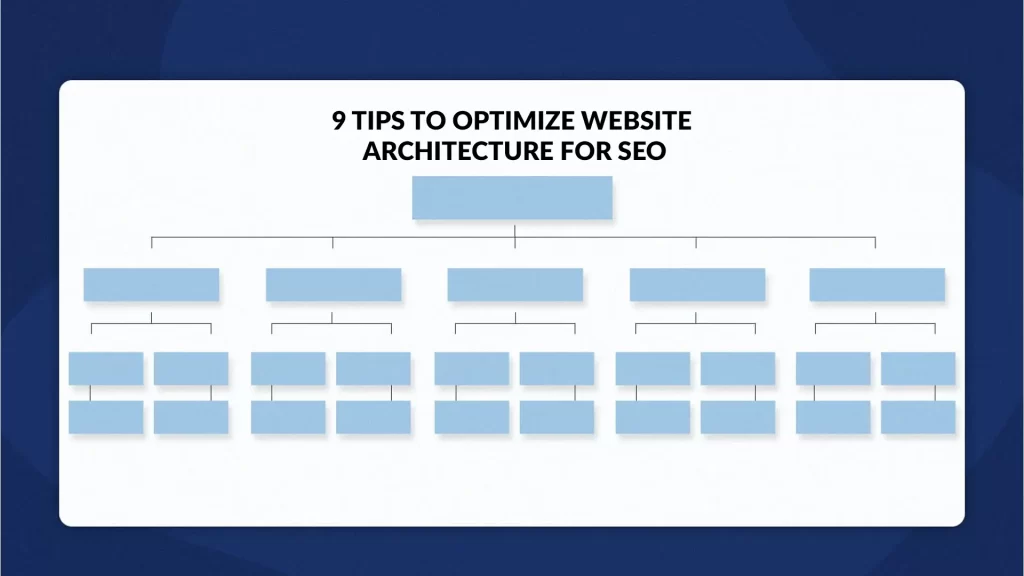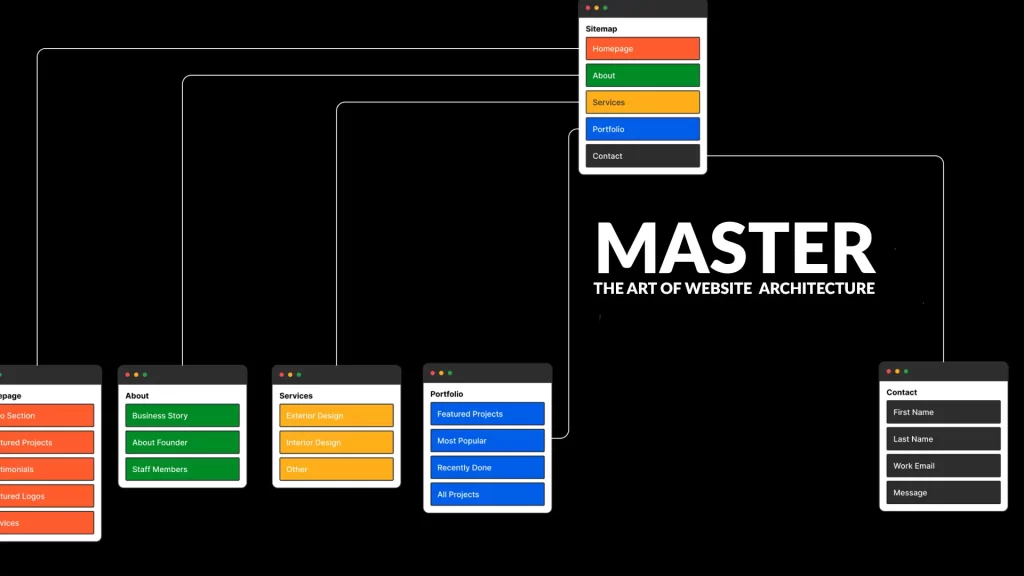Mastering the art of website architecture is like possessing the keys to a digital kingdom in the ever-changing world of SEO. With over 8 years of comprehensive experience dealing with varied entities such as financial institutions, agencies, IT firms, and start-ups, I’ve amassed a wealth of knowledge. These aren’t just my thoughts; they’re intended to be shared with SEO aficionados, businesses, and budding entrepreneurs.
I’m here at Mohit’s SEO Training to assist you through this educational trip, sparing you the trials and errors that come with the learning curve. By enrolling in our course, you will not only learn essential knowledge, but you will also have access to one-on-one question resolution, which will be a lifeline in your pursuit of SEO greatness. This is more than simply a course; it is your journey to SEO mastery and everlasting confidence in the digital arena.
What Is The Structure Of A Website?
The structure and connections between the pages of a website has a term – Architecture. A website’s ideal website architecture for users and search engines crawlers to find the content they’re looking for.
Why Is the Structure of a Website Important for SEO?
Three factors:
- A well-designed site architecture makes it easier for search engine spiders to access and index every page on your website. Googlebot will have trouble locating and indexing pages on your website if they are several clicks away from your homepage (or not linked from any other page at all). Your website’s site architecture distributes link authority.
- High-priority pages will receive increased link authority (PageRank) when you internal link to them. This can raise their Google ranking.
- Visitors can easily find what they’re looking for on your website with the correct website architecture.
What Kinds of Website Structures Are There?
Although there are many distinct types of website architecture, flat and planning site structure before construction, are the most prevalent:
- Flat site architecture: Flat websites are created so that both users and search engines may easily move through them from the homepage.
- Deep site structure: When your website is structured this way, it takes longer for visitors and search engines to find certain content. You can, however, make pages, particularly for particular subjects.
We can list the following four major forms of website structure if you want to delve a bit more into website structure types:
- One of the most popular styles of site architecture is the hierarchical model. This design is comparable to a tree with a trunk. All the other categories and sites would be the branches, with the homepage serving as the trunk. Hierarchical website structure like Databox is here for creating articles.
- When it comes to building individual web pages, the sequential paradigm is more common. The major goal is to guide the user step-by-step through a process. For instance, the creation of all of the pages in the Databox help articles happens with sequence in mind.
- The oldest site structure on the internet is referred to as the matrix model. Giving users the freedom to choose their destination is the aim. Users can navigate using the search bar or internal links. An excellent matrix model example is Wikipedia. Pillar pages, however, are a fantastic “substitute” for this style today.
- Database model: This final method of website structure is dynamic. This type of website structure must take into account the metadata of individual pages, follow sound information architectural principles, and follow taxonomic best practices.
Also Read: Google Sandbox

Why Is Website Architecture Important For SEO?
Enhances Indexability And Crawlability
Search engines must first comprehend the content of your site’s many pages to properly rank its content for relevant keywords. To accomplish this, spiders from search engines ingest the material from your website and index it. Search engines can quickly find all of your material and get a precise understanding of your site’s purpose when your site has a logical data architecture and internal link structure.
The creation of authoritative status
Grouping content that has a similar theme can help you become much more authoritative on a specific subject. By doing this, you may tell Google that your website covers the topic in great depth and breadth. Moreover, it becomes much simpler to rank for similar keywords once the search engines recognize you as a reliable source of information on a certain topic.
Also Read : An Ultimate Guide On How To Master YouTube SEO Effectively
Aids in creating site links
Google will help in generating natural sitelinks for SEO if your site architecture is sound. Sitelinks are sub-listings that sometimes appear in the top search results. Likewise, they make it possible for Google users to go immediately from the results page of a search to various website areas. Sitelinks can thereby increase your organic click-through rate (CTR). There is no obvious way to optimize site links because Google creates them on its own. But it’s safe to say that if Google has trouble crawling and understanding your website, you won’t get any site links.

Tips To Optimize Website Architecture For SEO
Create a site structure plan initially
The best suggestion is to create a plan for your site structure before you begin construction if you are creating a new website or redesigning an existing one. In addition, not only will it save you time later on in the construction process, but it will also guarantee that nothing is overlooked and that everything is configured properly.
Consider the hierarchy of information
The most typical website layout resembles an inverted pyramid, with the homepage at the top, a few top-level service pages below it, and more pages below that to provide more detail. Search engines determine the value of a page by looking at the website’s hierarchy.
Utilize header hierarchies
Your website’s hierarchy is planned out. It’s crucial to pay great attention to your tags’ hierarchical structure. Likewise, make sure that the title is in H1, then continue to H2 and H3. Some people tend to choose the tag based on the text’s size, however, it is a major SEO blunder.
Link to further, pertinent pages on your website
Because the pages on your website have a lot of potential to affect SEO rank, don’t forget to develop an internal linking plan. use internal links with descriptions! Make it obvious to Googlebot what the target page is all about rather than simply linking terms like “click here” or “more info” to the destination page.
Utilize basic navigational frameworks
A clear and uncomplicated navigation bar is necessary. A whopping 94% of users consider simple navigation to be the most helpful website feature. Limit the number of top-level menu items you have. Don’t use subcategories excessively. And make sure that each subcategory has a clear connection to the parent category. In your navigation bar, put a link to your homepage. Users will find it simple to restart as a result.
Employ breadcrumbs
Utilize breadcrumb navigation to show people how to get to a certain page. Similarly, this facilitates user navigation and aids in the comprehension of the relationships between pages by search engines.
Build a Site map
A sitemap is an outline of all the pages on your website that can be crawled. It shows your site’s architecture in a way that both search engines and people can read and crawl, making it a crucial component of your website’s architecture. HTML and XML sitemaps are the two sorts of sitemaps you should be concerned with.
Improve Page Load Time
Watch out for how quickly your website loads. Use caching techniques, reduce code, and compress pictures to speed up page loads.
Design for mobile devices
Make sure your website is mobile-friendly and responsive. Google prioritizes websites that are mobile-friendly in its results.
Conclusion
The user experience and SEO greatly depend on how your website is set up. If all else is equal, improving your site architecture will raise rankings and conversion rates.
Your website architecture can be improved in a variety of ways. Even if you believe that you developed your website flawlessly, there probably is still room for improvement. Starting points include adding subject clusters and carefully structuring URLs.
But the most crucial guideline is to keep things straightforward. Your website’s architecture will be simpler to handle as it expands if you can keep it that way.

Mohit Verma is an experienced professional with 9 years of experience in Search Engine Optimization. He has worked with many brands such as Bank of Baroda, 1boxoffice, and Ozonetel. He is on a mission to provide industry focused job oriented SEO and Google Ads Training, so the students/mentees can go and start working from day 1.
